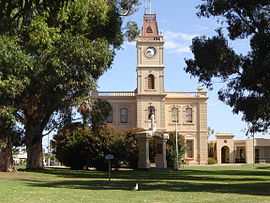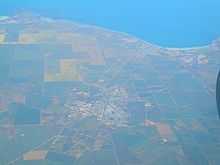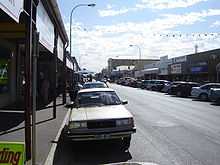Kadina, South Australia
- Kadina redirects here. For a similar spelling, see Kadena (disambiguation).
| Kadina South Australia | |||||||||||||
|---|---|---|---|---|---|---|---|---|---|---|---|---|---|
 Kadina Town Hall | |||||||||||||
 Kadina | |||||||||||||
| Coordinates | 33°57′0″S 137°42′0″E / 33.95000°S 137.70000°ECoordinates: 33°57′0″S 137°42′0″E / 33.95000°S 137.70000°E | ||||||||||||
| Population | 5,070 (2006)[1] | ||||||||||||
| Established | 1861 | ||||||||||||
| Postcode(s) | 5554 | ||||||||||||
| Elevation | 44 m (144 ft) | ||||||||||||
| Location | 144 km (89 mi) NNW of Adelaide | ||||||||||||
| LGA(s) | Copper Coast | ||||||||||||
| State electorate(s) | Goyder | ||||||||||||
| Federal Division(s) | Grey | ||||||||||||
| |||||||||||||
| |||||||||||||


Kadina is a town located on the Yorke Peninsula of South Australia, approximately 144 kilometres north-northwest of the state capital of Adelaide. The largest town of the Peninsula, Kadina is one of the three Copper Triangle towns famous for their shared copper mining history. The three towns are known as "Little Cornwall" for the significant number of immigrants from Cornwall that worked at the mines in the late 19th century. At the 2006 census, Kadina had a population of 4,000.[1]
It is about 20 kilometres (12 mi) north-east of Moonta and 8 kilometres east of the port town of Wallaroo. Kadina's suburbs are Kadina East, Wallaroo Mines, Jerusalem, Jericho, Matta Flat and Newtown.
The name "Kadina" is thought to be derived from Kadiyinya, an (indigenous) Narungga tribe word meaning 'Lizard Plain'.
History
The land that was to hold Kadina was surveyed in 1861 after copper was discovered at the site known as Wallaroo Mines (just southwest of today's Kadina town), by settlers who apparently saw wombats throwing copper to the surface. Exceptional amounts of copper were found in the following years. Copper was also found in large amounts at the nearby Matta mine. The discovery of copper attracted many highly experienced Cornish miners to Kadina. The population of Kadina increased to 20,000 by 1875, mostly composed of Cornish miners.
In 1872, Kadina became a municipality and in 1878, a train line opened connecting Kadina to Wallaroo and Bute (also on the Yorke Peninsula).[2] This rail line fell into disuse and was closed in 1989. Mining was completely stopped in 1938.
The town today consists of important historical colonial and federation buildings gathered around Victoria Square. Kadina and its surrounds are experiencing some minor growth due to the Copper Cove housing development at Wallaroo.
Kadina also contains the Farm Shed Museum & Tourism Centre (Kadina Heritage Museum) and remnants of the old Wallaroo Mines. The popular Kernewek Lowender, a Cornish festival, is held every odd year in May in Kadina (as well as Moonta and Wallaroo where each location holds the festival for one day).
The town is also the base for local radio station Gulf FM, broadcasting on 89.3.
Geography and climate
Kadina exists in a semi-arid location, above Goyder's Line, and is surrounded by mallee scrub. It is located 8 kilometres inland and 44 metres above sea level. Kadina has a dry Mediterranean climate with seasonal temperatures a few degrees above Adelaide's temperatures. The average winter temperature is 15.4°C and the average summer temperature is 30.5°C. Average rainfall of Kadina is 388.8 millimetres. The weather patterns are similar to those of Adelaide.
Kadina's surrounds are used for growing barley, wheat and other crops such as legumes, canola, chickpeas and field peas. Barley and wheat from the region is considered to be some of the best in the world.
Governance
The District Council of the Copper Coast governs Kadina at the municipal level. Kadina lies in the state electoral district of Goyder and the federal electoral Division of Grey.
Notable people from Kadina
- Richard Champion, former AFL footballer
- John Olsen, former South Australian Premier and South Australian Federal Senator
- Kerin Bailey, musician and composer
- Horace Wilson, cricketer
See also
- Wallaroo, South Australia
- Moonta, South Australia
- Cornish emigration
- Kernewek Lowender
References
- ↑ 1.0 1.1 Australian Bureau of Statistics (25 October 2007). "Kadina (Urban Centre/Locality)". 2006 Census QuickStats. Retrieved 2009-09-17.
- ↑ Callaghan, W.H. Horse and Steam, Wheat and Copper, Australian Railway Historical Society Bulletin, January;February, 2002 pp9-27;46-63
External links
| Wikimedia Commons has media related to Kadina, South Australia. |
| |||||
| ||||||||||||||